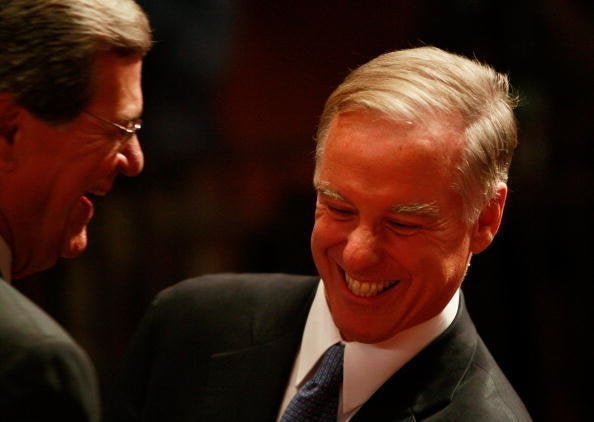
Fresh off an expansion in congressional majorities and the reclamation of the White House, the Democratic National Committee is sending around a memo that ties the success to Chairman Howard Dean's 50-state-strategy.
Noting that much of Obama's campaign principles expanded on the strategy Dean began implementing three years earlier, the memo pinpoints some of the highlights for the Party: having nearly 200 paid staffers across every state, organizing nearly 900 "pushback and bracketing events," hosting workshops across the country to train staff, and so on.
Two things in particular stand out as having truly tangible impact on Obama's victory:
Dean and the party made a strategic decision to push West, adding an early primary contest in Nevada and hosting the convention in Denver. Those two states - in addition to New Mexico - ended up flipping Obama's way. In addition, the DNC put in place a "neighbor-to-neighbor program" that gave grassroots organizers access to more voter information than they previously had. The results were a snowball effect of sorts: activists could talk to more people, gain more information, and report it back to their databases. The Obama camp took this philosophy and expanded on it, using person-to-person contact as a chief persuasion tool to recruit new voters.
The relative success of the DNC has persuaded some of Dean's early critics to re-examine their assessment, although Dean himself pleaded for eight years before grading the results of his 50-state-strategy. One of those critics - it should be noted - is Obama's new chief of staff, Rep. Rahm Emanuel who argued in 2006 that Democrats would be best suited to take their resources and devote them to winnable races rather than traditionally Republican strongholds.
Here is the Executive Summary of the DNC memorandum:
To: Interested Parties
From: DNC Communications
Date: 11/5/08
RE: A 50 State Strategy: Rebuild, Show Up, and Ask for People's Votes.
When Governor Dean became Chairman in February 2005, our Party had come through a dismal election cycle. We had just lost a national election to an incumbent president whose approval rating hovered at or below 50 percent. Republicans had gained 3 seats in the House and 4 in the Senate, leading to speculation about the possibility of a "permanent Republican majority."
Governor Dean's first step was to assess our Party's strengths and weaknesses and put in place a strategy to address those issues. Dean developed a business plan to rebuild the Democratic Party, modernize our operations and expand the electoral map. The emphasis was on lessons learned and best practices, and it included the following key components:
· Rebuild the Infrastructure of the Party - After assessing the needs on the ground, we hired full-time permanent staff in all 50 states, trained staff and activists, introduced new measures of accountability, and developed a unified technology platform. Over the past four years we've held 140 trainings for candidates, campaign staff, organizers, Party leaders and activists in all 50 states.
· Upgrade and Improve the Party's Technology/Modernize the Way We Do Grassroots Organizing - Over the past four years the DNC has made significant investments in technology, creating a truly national voter file, improved micro-targeting models and developed 21st century campaign tools that merged traditional organizing with new technology.
· Diversify the Donor Base - Shifting the emphasis of Party fundraising to include both small donors and large donors, the DNC brought in more than 1.1 million new donors and raised more than $330 million from '05 - '08. The average contribution over the last three years was $63.88.
· Amplify Democratic Message and Improved Outreach - Created a national communications infrastructure to amplify the Democratic message and reach out to groups we haven't always talked to and expand the map to regions where Democrats have not traditionally been competitive - including the South and the West.
· Professionalize Voter Protection Efforts - Created a year-round national, state and local effort to ensure that every eligible voter has the opportunity to vote.
When Obama Became the Nominee:
As a result of those efforts, when Barack Obama became our Party's nominee, we had unprecedented resources in place, including:
· Trained, Professional Staff on the Ground in All 50 States
· A State of the Art Voter File and Micro-targeting Tools
· The Neighbor-to-Neighbor Organizing Tool
· Initial Polling on McCain
· A political roadmap for 24 states
